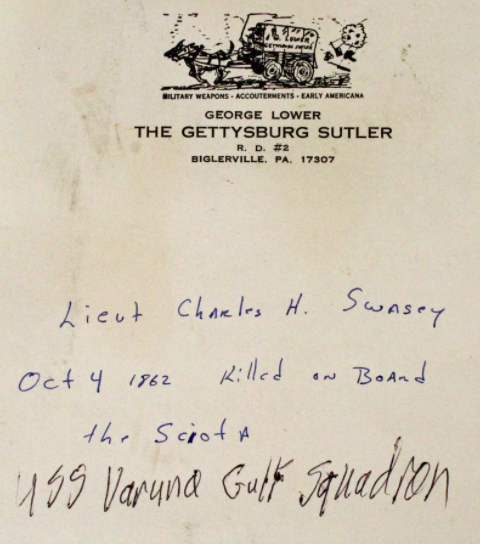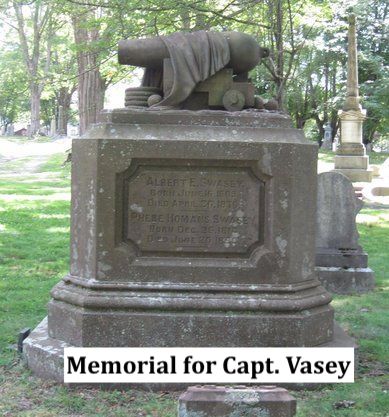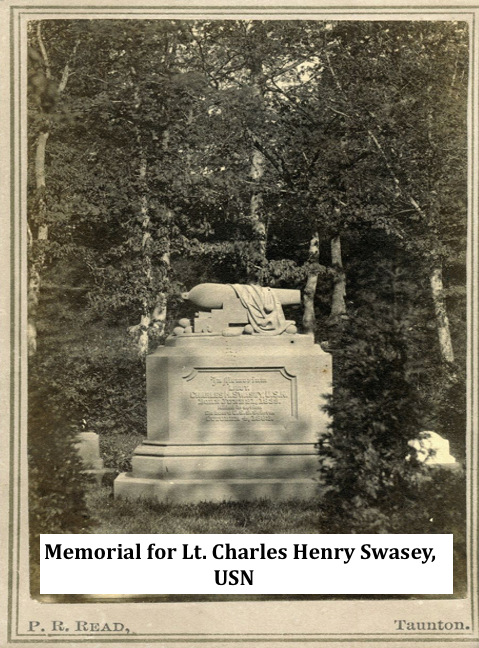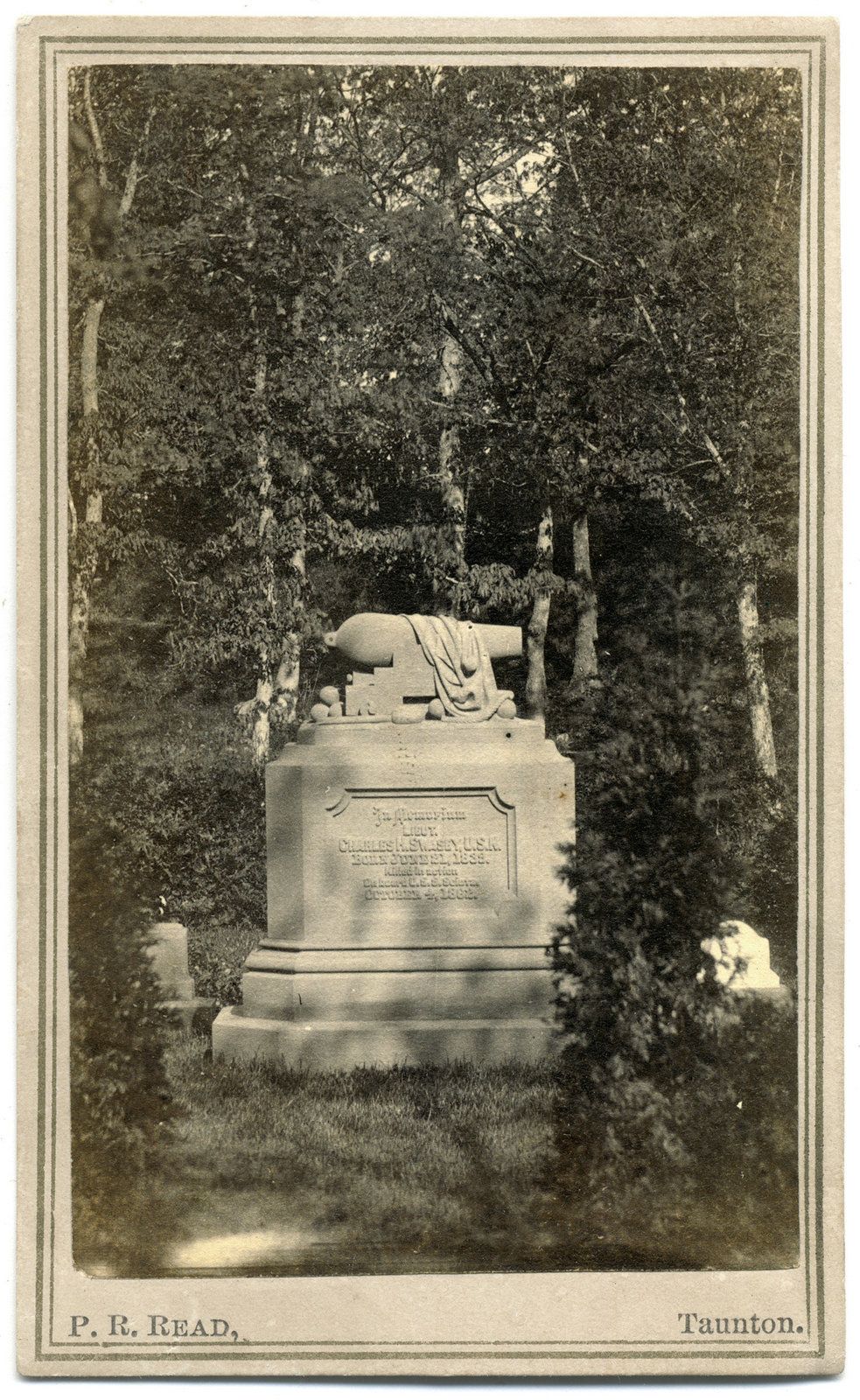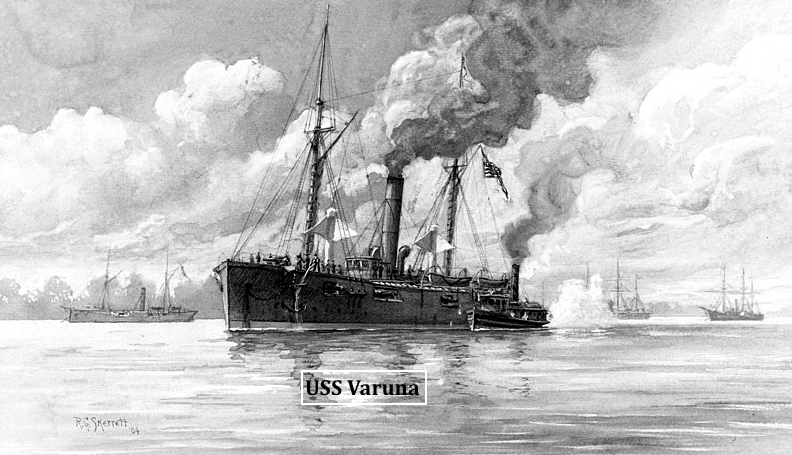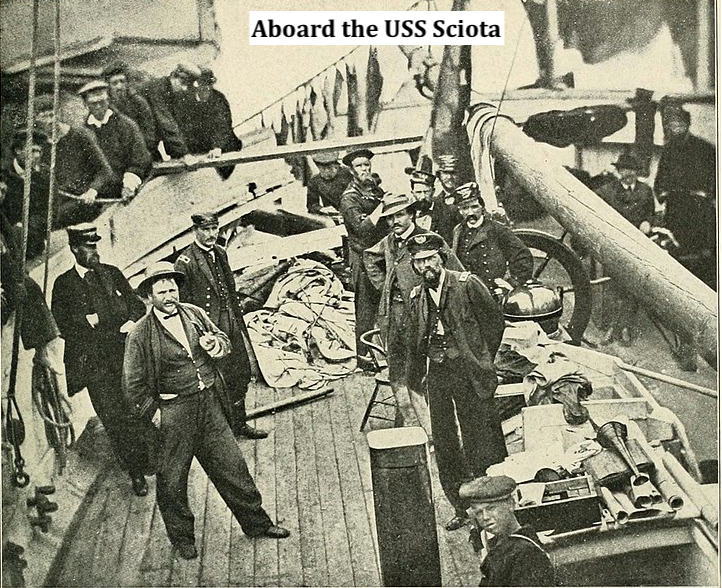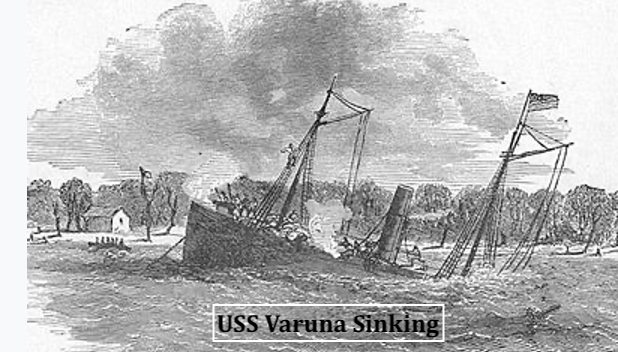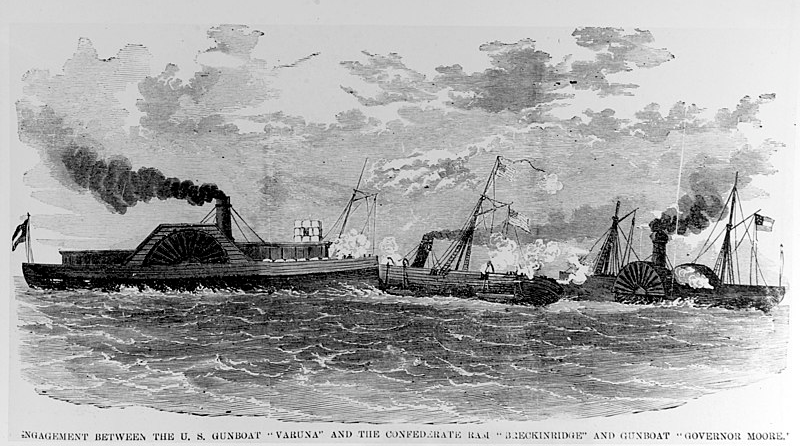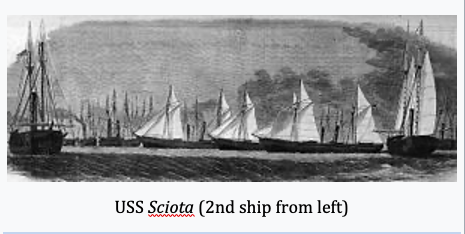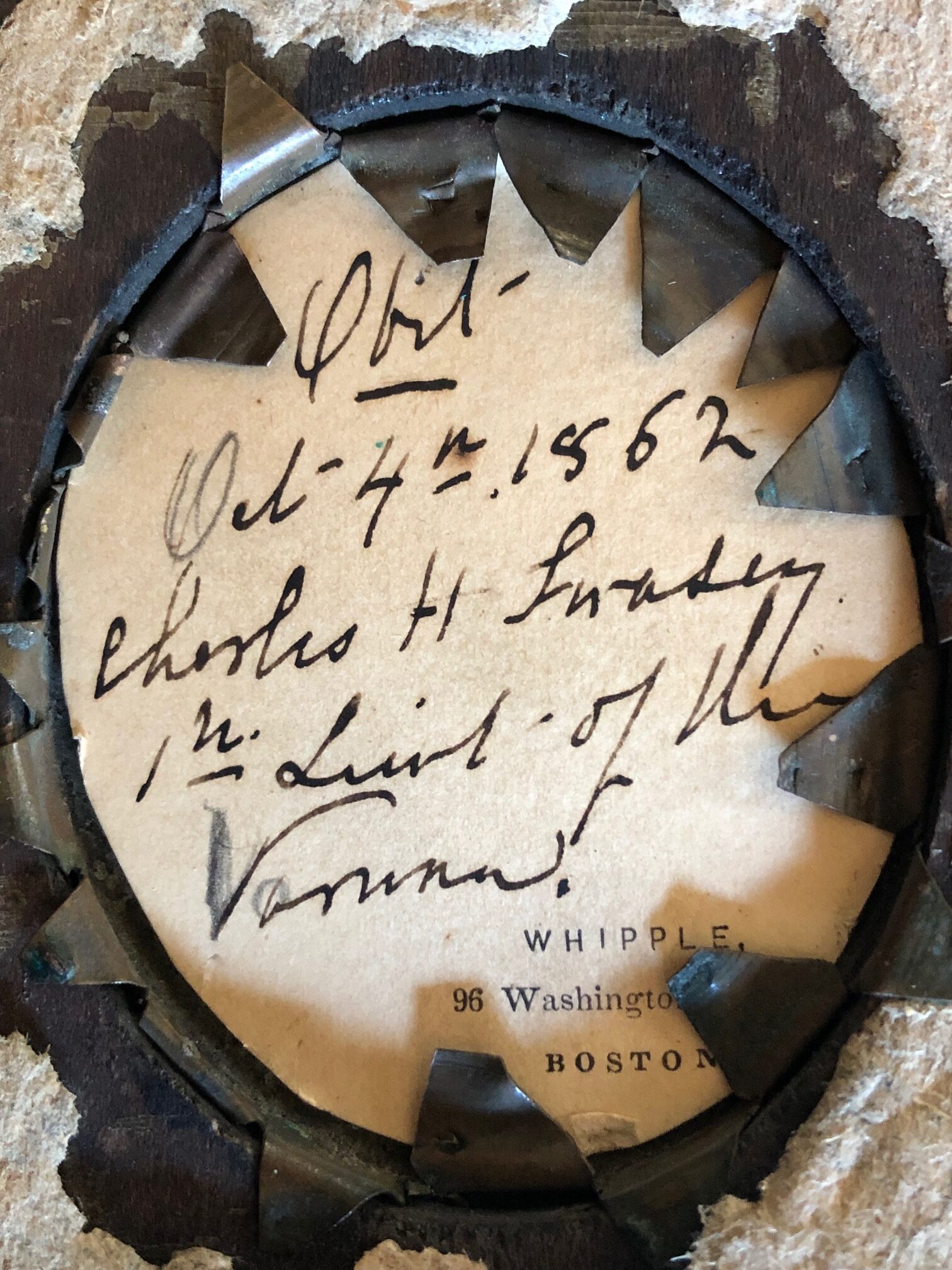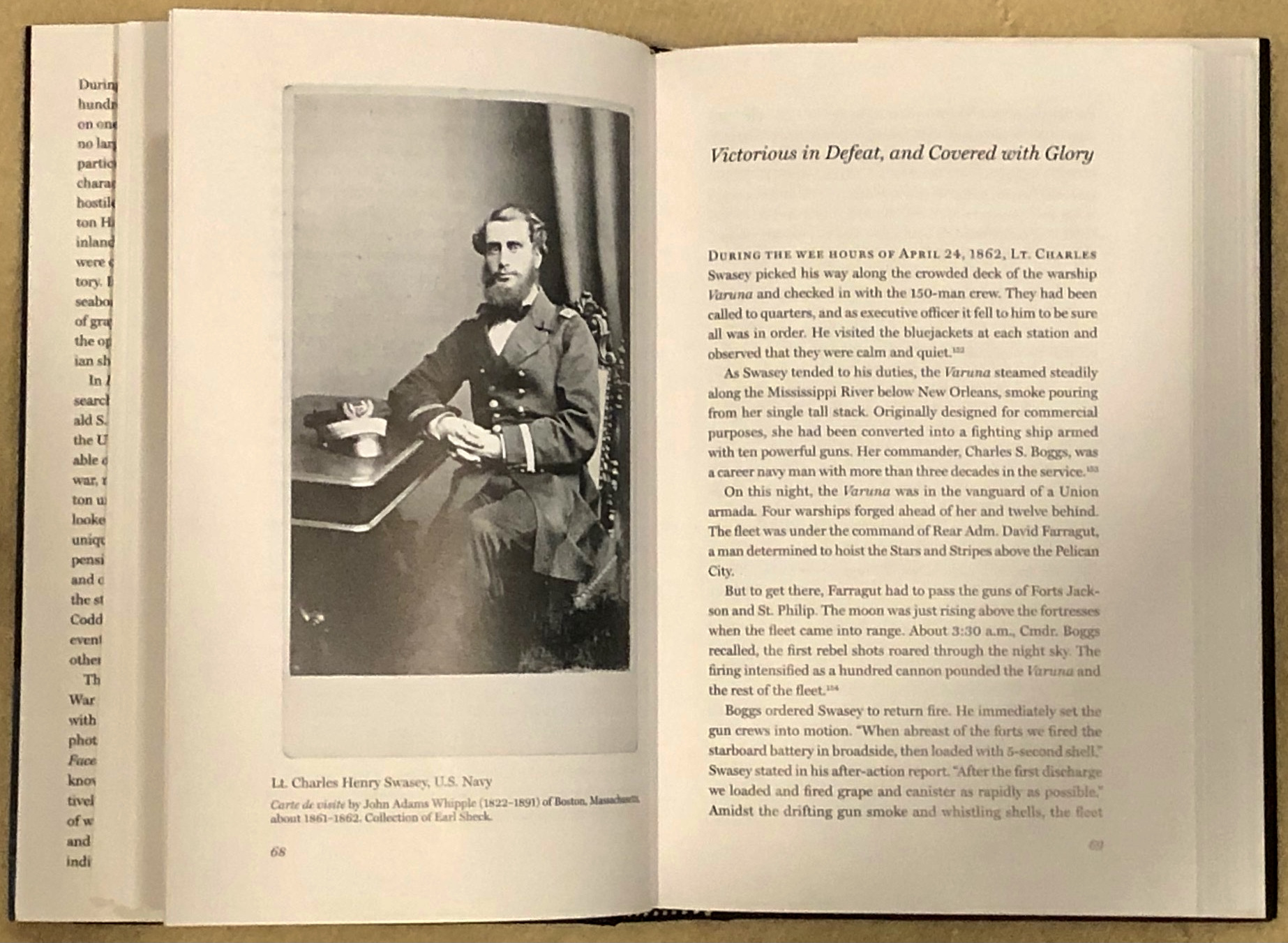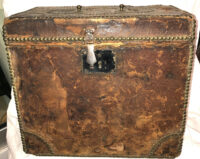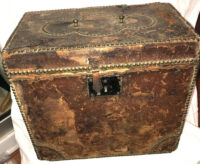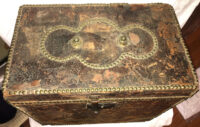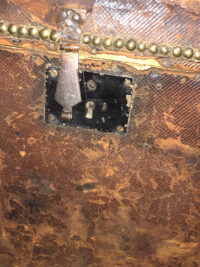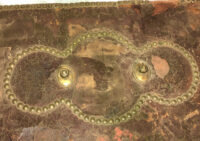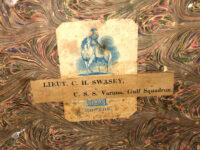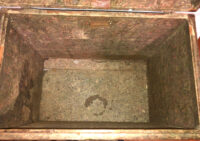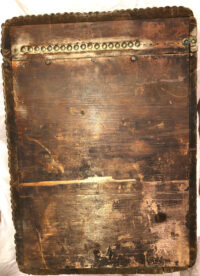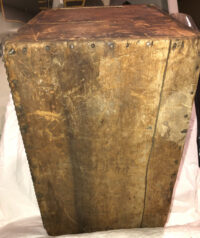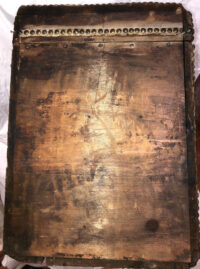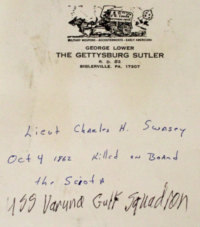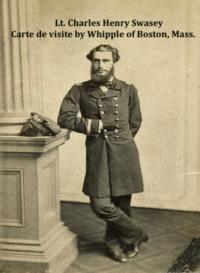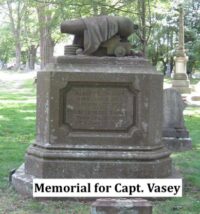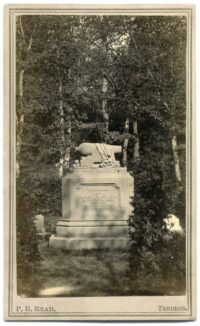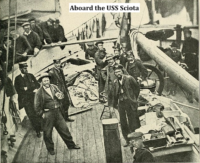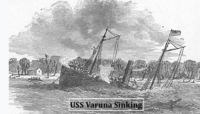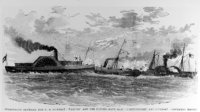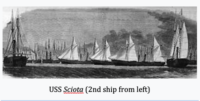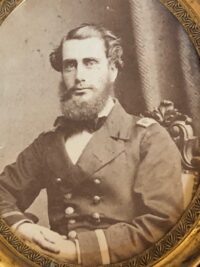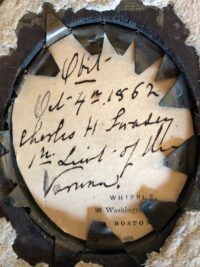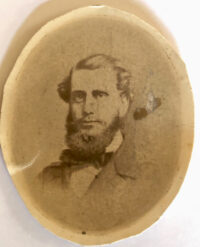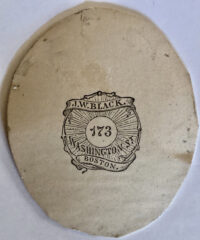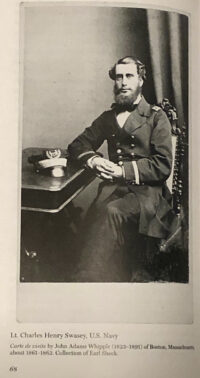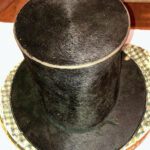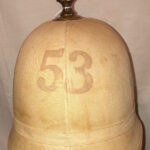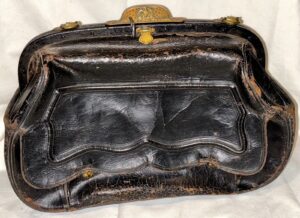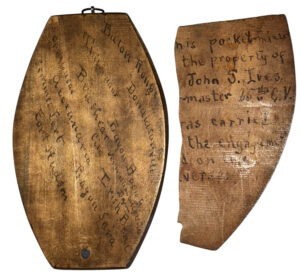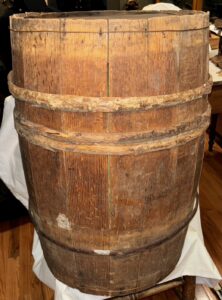Civil War Period Shipboard Trunk and CDV of Lieutenant Charles H. Swasey, Mortally Wounded
$1,150
Civil War Period Shipboard Trunk and CDV of Lieutenant Charles H. Swasey, Mortally Wounded – Lt. Swasey’s trunk was originally, fully, leather covered and embellished with decorative, brass tacks. The wood, which appears to be white pine, is in very good condition; the interior of the trunk is lined in a richly colored, marbled paper; the lid of the trunk is hinged with original butt hinges which are affixed to the trunk via original, hand-crafted, rose head nails. The interior lid of the trunk retains an original, paper nameplate which reads:
“LIEUT. C. H. SWASEY,
U.S.S. Varuna, Gulf Squadron.”
Charles H. Swasey (June 21, 1839- October 4, 1862) served aboard the USS Varuna during the engagement with the steamer, the CSS Governor Moore, down river from New Orleans, on April 24, 1862. Swasey later served as the executive officer of USS Sciota, on the West Gulf Blockading Squadron. While aboard the Sciota, Swasey was wounded during an engagement with Confederate forces near Donaldsonville, LA, on October 4,1862 and died the same day. Two later, U.S. Navy ships have been named USS Swasey, in his honor. The trunk remains in overall good condition, although only a modest amount of the original leather covering remains; most of the original brass tacks are in place; the wood is in very good condition. The trunk was apparently once part of the inventory of well-known, Gettysburg, collector and dealer, George Lower – a page of his “Gettysburg Sutler” stationary was in the trunk when we obtained it, listing the trunk’s owner as Lt. Swasey, KIA on board the Sciota.
Trunk measurements: Height – 14 1/2″; Length – 16″; Depth – 10″.
Accompanying Lt. Swasey’s trunk are two, period CDVs of Swasey, in uniform. One of the CDVs is in its original, ebonized, period, wood frame, perhaps a mourning frame. Written in ink, on the back of the CDV, which was trimmed, in a circular shape to fit in the frame, is the following:
“Obit –
Oct 4th 1862
Charles H Swasey
1st Lieut of the
Varuna”
When we first obtained this CDV, placed on the back of the frame, covering the above inscription, was a second, CDV of Lt. Swasey, also trimmed, in a circular shape. Both CDVs remain in good condition.
Charles H. Swasey
| Residence Massachusetts; Enlisted as a Midshipman (date unknown). Promotions:* Lieutenant 8/31/1861 He also had service in:UN Navy (Killed in action on USS SCIOTA) Ships served on in Navy:* USS HARTFORD * USS VARUNA * USS TENNESSEE * USS SCIOTA * East India Squadron * West Gulf Squadron Other Information:born in Massachusetts |
Born in Taunton on June 21, 1839, he was appointed to the Naval Academy on September 28, 1854. After graduation, his service began with a cruise to the East Indies as midshipman on the USS Hartford. On Aug. 31, 1861, he was commissioned as a lieutenant and assigned to the USS Varuna. Was with Farragut’s fleet during the New Orleans campaign,and was aboard Varuna during its engagement with CSS Governor Moore, on April 24, 1862. He next became executive officer on the gunboat USS Sciota in the West Gulf Squadron.
On Oct. 4, 1862, during an engagement with Confederate forces near Donaldson, Louisiana, he was wounded from the first shot which was fired a 1:30 p.m. He was hit by a 12-pounder rifle-shot which grazed his right hip and cut off his right hand. He died later that day at 3 p.m. It was reported that his last words were “Tell my mother I tried to be a good man.” Sciota’s captain, Lt.-Com. R. B. Lowry reported that Lt. Swasey gallantly performed his duties and had “all the elements which make up a hero – brave, imbued with patriotic ardor and professional ambition, chivalric as a gentleman, gentle, and with a heart full of Christian principles.” Admiral Farragut reported to the Navy Department that “lieutenant Swasey was a young man of modest merit, and would, no doubt, have continued to live, as he died, in the faithful discharge of his duties. I knew him slightly, but feel assured that he deserved all that his commander has said of him, and I deeply deplore this death, although he died at the post of honor.”
An image and bio. of Lt. Swasey is published in Ron Coddington’s fine book – Faces of the Civil War Navies, pages 68 – 73
Ronald S. Coddington (editor and publisher of Military Images Magazine):
“Victorious in Defeat, and Covered with Glory”
Carte de visite by Whipple of Boston, Mass. During the wee hours of April 24, 1862, Lt. Charles Henry Swasey picked his way along the crowded deck of the warship Varuna and checked in with the 150-man crew. They had been called to quarters, and as executive officer it fell to him to be sure all was in order. He visited the bluejackets at each station and observed that they were calm and quiet.
As Swasey tended to his duties, the Varuna steamed steadily along the Mississippi River below New Orleans, smoke pouring from her single tall stack. Originally designed for commercial purposes, she had been converted into a fighting ship armed with ten powerful guns. Her commander, Charles S. Boggs, was a career navy man with more than three decades in the service.
On this night, the Varuna was in the vanguard of a Union armada. Four warships steamed ahead of her and twelve behind. The fleet was under the command of Rear Adm. David Farragut, a man determined to hoist the Stars and Stripes above the Pelican City.
To get there, Farragut had to pass the guns of Forts Jackson and St. Philip. The moon was just rising above the fortresses when the fleet came into range. About 3:30 a.m., Cmdr. Boggs recalled, the first rebel shots roared through the night sky. The firing intensified as 100 cannon pounded the Varuna and the rest of the fleet.
Boggs ordered Swasey to return fire. He immediately set the gun crews into motion. “When abreast of the forts we fired the starboard battery in broadside, then loaded with 5-second shell,” Swasey stated in his after-action report. “After the first discharge we loaded and fired grape and canister as rapidly as possible.” Amidst the drifting gun smoke and whistling shells, the fleet became disordered. The Varuna was the first to make it free and clear of the forts—and straight into a hornet’s nest of enemy gunboats.
There was no way out but forward. Boggs ordered his pilot to steer the Varuna to the swarm of enemy vessels at point blank range, and Swasey to open up with everything they had. “The order was given ‘to work both sides’ and to load with grape,” Swasey reported. “Our guns were trained for extreme lateral train forward, and as we brought them to bear successively on the enemy’s vessels, ranged in succession on each side of the river, we fired, the guns having been first pointed with the greatest care. As far as my own observation showed me, in no case did we miss the object aimed at, and the effect of our firing seemed to keep the enemy aloof.”
Swasey continued, “Finding that we were getting too far from the enemy for the use of grape, we loaded with 5-second shell and fired. One of these shells struck a steamer and, bursting, carried away his port wheelhouse and exploded his boiler. Three other steamers were set on fire and driven ashore by our shell.”
By this time it was about 6 a.m. and the crew of the Varuna had been in action for two-and-a-half hours. Twice set afire by shells, the crew had acted quickly to extinguish the flames. Leaking badly and losing steam, she had almost passed through the entire enemy squadron. But at this moment two rebel warships reinforced with railroad iron and cotton bales attacked. The Governor Moore hit first. The side-wheel cotton-clad raked the port gangway with shot that took out 13 crewmen and rammed the Varuna twice. Swasey, at Boggs’s command, poured a few shells into the Moore and drove her back. Then a second cotton-clad, the Stonewall Jackson, rammed the Varuna with her iron-sheathed bow. The Varuna rocked from the blow. Stonewall backed off and rammed her again in the same place. The iron bow crushed the wooden side of the Varuna—a mortal wound. Boggs and Swasey, still on their feet, kept the gunners on target. They pumped five shells into the Stonewall and sent her reeling.
The cotton-clads dropped out of range, and after close encounters with other vessels in Farragut’s armada they were destroyed. The Varuna meanwhile was in her death throes as she took on river water. “I ran her into the bank, let go the anchors, and tied up to the trees,” Boggs reported. Swasey kept the crew at the guns and continued to fire until the water was over the gun tracks on deck. At this point the ship was evacuated.
Boggs recalled, “We were taken off by boats from the squadron who had now come up; the crews cheering as the Varuna went down with her flag flying; victorious in defeat, and covered with glory.” The Varuna came to rest on the bottom of the Mississippi, only her topgallant forecastle visible above the waterline.
The Varuna was dead. Boggs, Swasey and their crewmates had inflicted serious damage on the rebel fleet. They had destroyed four warships outright and contributed to the destruction of two others. Five days later New Orleans fell to federal forces.
The story of the Varuna made newspaper headlines across the Union. The deeds of the crew became the stuff of legend, and inspired a poem. In The Varuna, George H. Boker celebrated the shop and extolled the crew: “Cherish the heroes who fought the Varuna; Treat them as kings if they honor your way.”
Swasey found temporary quarters on the Brooklyn, where he wrote a detailed after action report. He singled out a number of the crew for their actions, of which eight were awarded the Medal of Honor. Swasey also paid tribute to Boggs. “Permit me to thank you for the many kindnesses received at your hands while under your command, and I desire to express the regrets of the crew in losing a commander under whom they enjoyed many pleasant hours.”
Swasey’s compliment carried the weight of his own experience in the navy. Back in 1854, at age 15, he had left his family in Taunton, Massachusetts, and entered the Naval Academy. He graduated in 1859 and began his career on the Hartford, then a part of the East India Squadron. A few months after the start of the Civil War, he was promoted to lieutenant and before the end of the year was detached from the Hartford. In January 1862 he was assigned to the Varuna and the West Gulf Squadron. His tenure as executive officer of the Varuna lasted about three months.
Two weeks after the Varuna sunk, Swasey was named temporary commander of the Tennessee. The warship had been seized by rebels in 1861 and added to the Confederate navy. She was recaptured and returned to federal service after the fall of New Orleans.
Swasey soon left the Tennessee to become the executive officer of the gunboat Sciota. In the months that followed, the Sciota and other vessels came under increasing risk of ambush by partisan groups hidden along the Mississippi River. These irregular forces had moved into the area north of New Orleans following the occupation of the city.
During the early fall of 1862 Swasey and the Sciota joined a convoy charged with the disruption of enemy supply routes from Texas to the eastern Confederacy. On October 1, near Donaldsonville, Louisiana, they spotted a herd of 1,500 longhorn cattle. Swasey was placed in command of a landing party and sent to investigate. He returned with five drovers. After an interrogation, it was learned that the cattle were headed from Texas to Camp Moore, a Confederate base about 80 miles north. The navy confiscated the herd and loaded most of the cattle on five transports.
On the afternoon of October 4, the convoy set out for New Orleans with the Sciota in the lead. About 2:10 p.m. a few miles south of Donaldsonville, a masked battery opened fire on the Sciota. Anticipating an attack, the decks had been cleared and the crew immediately went into action. Swasey aimed a gun at the battery and just as it fired a 12-pound rebel shot tore through the bulwark of the Sciota. It struck Swasey in the hip and hand, almost severing his body in two. He lingered until about 3 o’clock. His last words were, “Tell my mother I tried to be a good man.” He was 28 years old.
The following morning, a Sunday, the Sciota and the rest of the convoy arrived in New Orleans and Swasey’s remains were sent ashore. Later that day funeral services were held and the body transferred to the steamer Potomac for the final journey to his family in Massachusetts. His remains are buried in Mount Pleasant Cemetery in Taunton, Mass.
The commander of the Sciota, Reigart B. Lowry, paid tribute to his executive officer in an official report. “This officer was characterized by all the elements which make up the hero—brave, imbued with patriotic ardor and professional ambition, chivalric as a gentleman, gentle, and with a heart full of Christian principles.” He added, “I respectfully request that his death, so heroic and noble, may be especially known to the nation through the Navy Department.”
Two fighting ships were named in his honor, a destroyer commissioned in 1919 and a destroyer escort launched in 1943.
USS Sciota (1861
| History | |
| United States | |
| Name | USS Sciota |
| Builder | Jacob Birely (Philadelphia) |
| Cost | $96,000 |
| Launched | 15 Oct 1861 |
| Commissioned | 15 Dec 1861 |
| Fate | Struck mine and sank, 14 Apr 1865; salvaged; sold 25 Oct 1865 |
| General characteristics | |
| Class and type | Unadilla-class gunboat |
| Displacement | 691 tons |
| Tons burthen | 507 |
| Length | 158 ft (48 m) (waterline) |
| Beam | 28 ft (8.5 m) |
| Draft | 9 ft 6 in (2.90 m) (max.) |
| Depth of hold | 12 ft (3.7 m) |
| Propulsion | 2 × 200 IHP 30-in bore by 18 in stroke horizontal back-acting engines; single screw |
| Sail plan | Two-masted schooner |
| Speed | 10 kn (11.5 mph) |
| Complement | 114 |
| Armament | ·Original:
·1 × 11-in Dahlgren smoothbore ·2 × 24-pdr smoothbore ·2 × 20-pdr Parrott rifle |
USS Sciota was a Unadilla-class gunboat built on behalf of the United States Navy for service during the Civil War. She was outfitted as a gunboat, with both a 20-pounder rifle for horizontal firing, and two howitzers for shore bombardment, and assigned to the Union blockade of the waterways of the Confederate States of America.
Commissioned in Philadelphia in 1861
The first U.S. Navy ship to be so named, USS Sciota was one of the “ninety-day gunboats” rushed through construction at the beginning of the Civil War, Sciota was laid down in the summer of 1861 at Philadelphia by Jacob Birley and J. P. Morris and Company; launched on 15 October 1861; and commissioned at the Philadelphia Navy Yard on 15 December 1861, Lieutenant Edward Donaldson in command.
Civil War service
Assigned to the Gulf Blockade
The new screw gunboat was assigned to the Gulf Blockading Squadron and arrived at Ship Island, Mississippi, on the afternoon of 8 January 1862. On 6 February, she captured blockade runner, Margaret, off Isle of Breton, Louisiana, as the sloop was attempting to escape to sea laden with cotton.
When Secretary of the Navy Gideon Welles divided naval jurisdiction in the Gulf of Mexico between Flag Officer William McKean and Flag Officer David Farragut, Sciota was assigned to Farragut’s West Gulf Blockading Squadron which had been created to wrest New Orleans from Southern hands.
During the first weeks in April, Sciota, supported Farragut’s efforts to get his deep draft ships across the bar off Pass a L’Outre and into the Mississippi River. During this period, she also steamed up the river gathering information about Southern defenses.
Bombarding Mississippi River forts
On the 18th, the ships of Farragut’s fleet took position close to Fort St. Philip and Fort Jackson. Sciota bombarded these forts, and she continued to duel with the Confederate guns intermittently for the next six days.
In the early morning darkness of the 24th, Sciota got underway with the fleet and dashed up river past the forts. After New Orleans, surrendered, Sciota operated up the river with Farragut. She attacked and passed the Confederate forts at Vicksburg, Mississippi on 28 June when Farragut raced by that riverside stronghold to join Flag Officer Charles H. Davis‘ Western flotilla.
Since the Army was unable to provide the troops necessary for joint operations against Vicksburg, Farragut decided to return down river to turn his attention to the blockade in the western gulf. Sciota again ran the gauntlet past the Southern batteries.
The gunboat continued operations on the Mississippi below Vicksburg for much of the remainder of the year. She engaged Southern batteries at Donaldsonville, Louisiana, on 4 October.
Gulf of Mexico operations
On 3 January 1863, Farragut ordered gunboats, Sciota, Cayuga, and Hatteras to Galveston, Texas which had just been captured by the South in a surprise attack shortly after midnight on New Year’s Day. On the 10th, Commodore Bell, in Brooklyn led an attack by Sciota, Owasco, and Katahdin on the Confederate batteries at Galveston. They learned that the Southern guns were capable of firing past the Union squadron-more than two and one-half miles.
After the engagement, Sciota continued to operate in the Gulf of Mexico, bolstering the still leaky blockade in the area. On 14 July 1863, she collided with the Union steamer, Antona, in the Mississippi River about eight miles above Quarantine and sank. However, she was raised late in August and taken to New Orleans to be refitted.
Returned to operations after having been sunk
The ship returned to blockade duty off the Texas coast early in December. On the last day of 1863, she and Granite City made a reconnaissance from Pass Cavallo, and landed soldiers on the gulf shore of Matagorda Peninsula in action continuing through 1 January 1864.
While Granite City covered the troops ashore from attacks by Confederate cavalry, Sciota reconnoitered the mouth of the Brazos River. Returning to the landing area, Sciota anchored close to the beach and shelled Confederate positions. Granite City steamed down to Pass Cavallo to call up Monogahela, Penobscot, and Estrella to assist. Confederate gunboat, John F. Carr, closed and fired on the Union troops, making some very good hits, but was driven ashore by a severe gale and destroyed by fire. The Union troops were withdrawn on board ship. Reporting on the operation, Lt. Col. Frank S. Hasseltine wrote:
“Captain Perkins, of the Sciota, excited my admiration by the daring manner in which he exposed his ship through the night in the surf till it broke all about him, that he might, close to us, lend the moral force of his … guns … and by his gallantry in bringing us off during the gale.”
On 21 January 1864, Sciota and Granite City joined several hundred troops in a reconnaissance of the Texas coast. They covered the troops at Smith’s Landing, Texas, and the subsequent foray down the Matagorda Peninsula.
On 4 April, Sciota captured the schooner Mary Sorly attempting to run the blockade at Galveston with a cargo of cotton. She had previously been United States Revenue Cutter, Dodge, seized by the Confederates at Galveston at the war’s outbreak.
Sciota continued operations on the Texas coast through the summer. On 13 September, she came across a large quantity of cotton afloat at sea, picked up 83 bales, and sent them to New Orleans. On 27 October, she captured Prussian schooner, Pancha Larispa, attempting to run through the blockade into either Velasco or San Luis Pass, Texas. The next day, she took Cora Smyser while that British schooner vainly attempted the same feat.
Sunk while clearing mines
In November, Sciota was ordered to Pensacola, Florida for repairs. In January 1865, she steamed to Mobile Bay to help clear torpedoes from the waters there. On 14 April, the day of President Abraham Lincoln‘s assassination, she struck a torpedo and sank off Mobile, Alabama. Her commanding officer, Acting Lieutenant James W. Magune, reported:
“The explosion was terrible, breaking the beams of the spar deck, tearing open the waterways, ripping off starboard forechannels, and breaking fore-topmast.”
Hulk raised and sold
Early in July, she was raised. Her hulk was sold at public auction at New York City on 25 October 1865.
USS Varuna (1861)
| USS Varuna | |
| History | |
| United States | |
| Builder | Mallory Yard, Mystic, Connecticut |
| Laid down | January or early February 1861 |
| Launched | September 1861 |
| Acquired | 31 December 1861 at New York City |
| Commissioned | circa February 1862 |
| Out of service | 24 April 1862 |
| Stricken | 1862 (est.) |
| Fate | sunk in action 24 April 1862 |
| General characteristics | |
| Displacement | 1,300 tons |
| Length | 218 ft (66 m) |
| Beam | 34 ft 8 in (10.57 m) |
| Depth of hold | 18 ft 3 in (5.56 m) |
| Propulsion | ·steam engine
·screw-propelled |
| Speed | not known |
| Complement | not known |
| Armament | ·eight 8″ guns
·two 30-pounder Parrott rifles |
USS Varuna (1861) was a heavy (1,300 ton) steam-powered ship acquired by the Union Navy during the early days of the American Civil War. She was outfitted with powerful 8-inch guns and assigned, as a gunboat, to the Union blockade of the waterways of the Confederate States of America.
Built in Connecticut
Varuna, the first U.S. Navy ship to bear the name, was originally intended for merchant service between New York City and New Orleans. She was laid down in late January or early February 1861 at the Mallory Yard, Mystic, Connecticut; launched there in the following September; and purchased by the Navy at New York City on 31 December 1861.
Civil War service
Joining the Union blockade
On 10 February 1862, she was ordered to remain in New York until Monitor was ready for action so that she might escort the new ironclad from New York to Hampton Roads, Virginia, to protect the wooden-hulled Union blockaders there from the Southern armored ram, CSS Virginia.
However, these orders were revoked later that same day; and Varuna was assigned to the newly established West Gulf Blockading Squadron. En route south late in February, Varuna put into Port Royal, South Carolina, for repairs, where the ship’s commanding officer, Commander Charles S. Boggs, assumed temporary command of the harbor on 24 February during Flag Officer Samuel F. Du Pont‘s absence. The gunboat finally joined Rear Admiral David G. Farragut‘s West Gulf Blockading Squadron on 6 March.
Mississippi River operations
On 24 April 1862, Varuna was with the squadron during Farragut’s daring nighttime dash past Confederate works guarding the Mississippi below New Orleans – Fort Jackson and Fort St. Philip.
Varuna sunk in action
At the height of the melee, Varuna was rammed twice by the steamer CSS Governor Moore and struck twice again immediately thereafter by the cotton-clad ram CSS Stonewall Jackson. After striking Varuna, CSN Lt. Beverly Kennon, in command of one of the Confederate warships, Governor Moore – found himself unable to depress his guns far enough to fire upon the Union vessel. So he shot through the bow of his own ship and used the resulting hole as a gun port.
Fatally damaged, Varuna backed off from the Confederate vessels and continued to subject them to a withering fire until rising water silenced her guns. Eight sailors of the Varuna received the Medal of Honor for their actions during the battle: Seaman Thomas Bourne, Landsman Amos Bradley, Captain of the Forecastle John Greene, Third Class Boy George Hollat, Seaman William Martin, Quartermaster John McGowan, Coxswain William McKnight, and Second Class Boy Oscar E. Peck.[1][2]
USS Varuna in battle with Confederate warships.
USS Varuna sinking
Varuna honored with a poem
Rear Admiral Farragut’s stunning victory at and subsequent capture of New Orleans itself electrified the North. Varuna’s part in the Union triumph was soon commemorated in George Henry Boker‘s poem, “The Varuna”, which appeared in the Philadelphia Press on 12 May.













